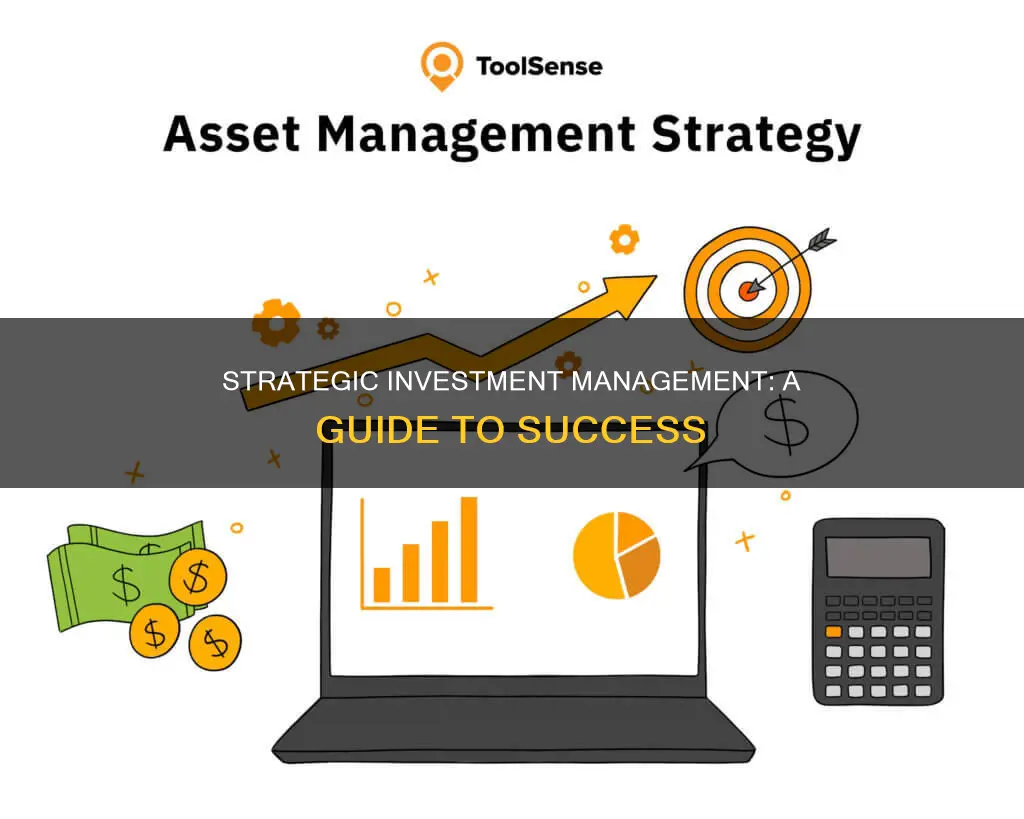
Managing investments is a complex task that requires careful planning and a good understanding of the market. The first step to managing investments is to set clear goals and define short-term needs and long-term aspirations. This will guide the selection of investment assets. Diversification is key to managing risk and cushioning losses. It is important to regularly monitor economic conditions, market trends and personal circumstances, and rebalance your portfolio to ensure it remains aligned with your goals. Managing investments also involves finding the right balance between financial goals, risk tolerance and time horizon.
| Characteristics | Values |
|---|---|
| Set clear goals | Define short-term needs and long-term aspirations |
| Diversify your portfolio | Allocate among different asset classes |
| Monitor market trends | Keep up with market trends and developments |
| Plan for tax obligations | Know what's required and save up for taxes |
| Rebalance your portfolio | Periodically realign the assets in your portfolio |
| Avoid emotional investing | Create a clear plan and follow it |
What You'll Learn

Set clear investment goals
Setting clear investment goals is an important first step in managing your investments. Here are some key considerations to help you set clear and effective investment goals:
Identify Your Reasons for Investing:
Before setting specific investment goals, take time to reflect on what's important to you. Consider your life goals and priorities. Are you planning to buy a house, start a family, or retire early? Understanding your motivations will help you define your investment objectives.
Set Specific and Measurable Goals:
Clear investment goals should be well-defined and specific. For example, your goal could be to save for a down payment on a house or to build an emergency fund. Make sure your goals are measurable so that you can track your progress and determine if you're on the right track.
Ensure Your Goals are Achievable and Realistic:
It's important to set realistic goals that are within your reach. Consider your financial situation, income, and risk tolerance when setting investment goals. Setting achievable goals will help you stay motivated and ensure that you don't take on unnecessary risks.
Define Your Time Horizons:
Different goals will have different time horizons. Categorize your goals into short-term (less than 5 years), medium-term (5-10 years), and long-term (10+ years). This will help you choose the right investment strategies and align your investments with your goals.
Assess Your Risk Tolerance:
Consider how much risk you are willing and able to take. Your risk tolerance will depend on factors such as your age, financial commitments, and investment goals. If you're investing for the long term, you may be able to take on more risk, while short-term goals might require a more conservative approach.
Create a Diversified Portfolio:
Diversification is a key aspect of effective investment goal setting. Build a portfolio that includes a mix of asset classes and investment types. Diversification helps protect your portfolio from market ups and downs, as different investments are affected by various factors such as economic conditions, interest rates, and political events.
Make Use of Tax-Efficient Accounts:
When setting investment goals, consider utilizing tax-efficient accounts such as pensions or Individual Savings Accounts (ISAs). These accounts offer tax advantages that can help your investments grow faster. Consult a financial advisor to explore tax-efficient investment opportunities.
Regularly Review and Adjust Your Goals:
Markets fluctuate, and your circumstances may change over time. Therefore, it's crucial to review your investment goals periodically. Assess your progress, adjust your investment strategies, and make any necessary changes to ensure your goals remain achievable and aligned with your priorities.
Remember, setting clear investment goals is a personal process that depends on your unique circumstances and aspirations. By following these steps, you can set effective investment goals that will guide your financial decisions and increase your chances of achieving your desired outcomes.
The Cycle of Savings, Borrowing, and Investing: Understanding the Trio
You may want to see also

Diversify your portfolio
Diversifying your portfolio is a crucial investment strategy that can help you manage risk and maximise returns. Here are some detailed tips to help you diversify your portfolio effectively:
Spread the Wealth
Diversification is about not putting all your eggs in one basket. Spread your investments across different asset classes, such as equities, commodities, exchange-traded funds (ETFs), and real estate investment trusts (REITs). Consider investing in a range of companies and sectors that you know and trust, and don't be afraid to think globally. However, keep your portfolio manageable—limit yourself to around 20 to 30 different investments.
Consider Index and Bond Funds
Index funds and fixed-income funds can be a great addition to your portfolio. These funds track various indexes or try to match the performance of broad indexes like the bond market. They provide long-term diversification and hedge your portfolio against market volatility. Index funds also tend to have low fees, which means more money in your pocket. However, keep in mind that they are passively managed, which might be suboptimal in inefficient markets.
Keep Building Your Portfolio
Regularly add to your investments using a strategy called dollar-cost averaging. This approach helps smooth out market volatility by investing the same amount of money over time. You'll buy more shares when prices are low and fewer when prices are high, reducing your overall investment risk.
Know When to Get Out
While buying and holding, and dollar-cost averaging are sound strategies, it's important to stay informed about your investments and overall market conditions. Keep an eye on the companies you invest in, and be prepared to cut your losses and move on when necessary.
Keep an Eye on Commissions
Understand the fees you are paying to your investment firm or broker. Some charge monthly fees, while others charge per transaction. Be aware of any changes to your fees, and remember that the cheapest option is not always the best.
Asset Allocation
Broadly, investments can be divided into two types: stocks and bonds. Stocks are typically high-risk and high-return, while bonds are more stable with lower returns. Allocate your investments between these two options to minimise risk. A good rule of thumb is to subtract your age from 100—this should be the percentage of stocks in your portfolio. For example, a 30-year-old could have 70% stocks and 30% bonds. As you get older, reduce your risk exposure by increasing the percentage of bonds.
Assess Qualitative Risks
Before investing in a stock, apply qualitative risk analysis to minimise unpredictability. Evaluate the stability and potential of the stock using parameters such as business model, management integrity, corporate governance, brand value, compliance, risk management practices, and dependability of products or services.
Invest in Money Market Securities
Money market instruments, such as certificates of deposit, commercial papers, and treasury bills, offer low risk and easy liquidation. Treasury bills, backed by the central government, are particularly safe and ideal for short-term investments. While they may not offer high returns, they can be a stable part of your portfolio.
Invest in Bonds with Systematic Cash Flows
Mutual funds are a stable investment option, and you can enhance their flexibility by investing in those with systematic cash flows or systematic withdrawal plans. These allow you to withdraw a fixed amount monthly or quarterly, providing access to your money even while it's locked in a savings plan.
Follow a Buy-and-Hold Strategy
Think long-term and avoid knee-jerk reactions to market fluctuations. A buy-and-hold strategy involves keeping a stable portfolio, allowing your investments to grow over time. However, don't be afraid to cut back on holdings that have appreciated too quickly or are taking up too much of your portfolio.
Understand Market Factors
Before investing, understand the factors that influence financial markets, such as interest rates, inflation, and central bank monetary policies. These external factors impact market dynamics, and it's crucial to consider them when making investment decisions.
Learn About Global Markets
Global markets offer the potential for high returns in a short time, but they come with their own set of challenges. As an investor, take the time to understand how these markets function, including trends, fluctuations, and driving forces. Start with exchange-traded funds (ETFs) or mutual funds with low-cost structures to invest safely and learn the ropes.
Rebalance Your Portfolio Periodically
Periodically review and rebalance your portfolio to ensure it aligns with your goals and milestones. A financial advisor can help you with this process, providing discipline and insight into your investments.
Try a Disciplined Investment Scheme
If you're investing a small amount over time rather than a large sum at once, consider a systematic investment plan (SIP). This allows you to invest a fixed amount in mutual funds at regular intervals, making it ideal for those with limited capital. SIPs also help instil discipline in your investment strategy and are based on compound interest with low overall risk.
Savings Plans: Invest Now, Reap Long-Term Benefits
You may want to see also

Monitor market trends
Monitoring market trends is a crucial aspect of investment management. Here are some detailed instructions on how to effectively monitor market trends:
- Understand Market Trend Timeframes: Market trends can be classified into three categories: secular (long-term), primary (medium-term), and secondary (short-term). Secular trends focus on companies or sectors expected to continue moving in the same direction for at least five years. Primary trends look at anticipated movements for the next year, guided by the previous year's performance. Secondary trends concentrate on short-term price fluctuations over weeks or months.
- Analyse Historical Share Price Movements: Market trend analysis involves examining historical share price patterns to gain insights into their future direction. While past performance doesn't guarantee future results, it can enhance your understanding of specific sectors or investments.
- Utilise Charts and Tables: Utilise charts or tables that illustrate past price movements in the stock market. This visual representation can help you identify patterns and make more informed decisions.
- Study Mass Psychology: Analysing human mass psychology is an integral part of market trend analysis. Understanding the collective behaviour, sentiments, and expectations of investors can provide valuable insights into market trends.
- Identify Patterns: Look for patterns in price movements and behaviour. This involves spotting similarities or recurring themes in market behaviour over time.
- Stay Informed: Read extensively and monitor both financial and general news. This will help you identify broader economic, political, and societal trends that can impact individual companies or sectors.
- Keep an Eye on Technology: Technology has been a significant disruptor over the past 25 years, and its impact is expected to continue. Stay abreast of future tech trends, such as automation, cloud computing, and advancements in biological sciences.
- Monitor Rival Companies: Keep a close eye on the performance of rival companies in the same industry. This can provide early warning signs of changing market trends and help you make more strategic decisions.
- Spotting Trends Early: Guessing how the economy and society may evolve in the next decade is crucial. Stay ahead by consuming a variety of information sources and monitoring news beyond just the financial sector.
- Cryptocurrency Considerations: If you're investing in cryptocurrencies like Bitcoin, remember that this is a relatively new and volatile field. Monitor market trends and developments, as they are often influenced by global economic factors, regulations, and technological advancements.
Planning Savings and Investments: Strategies for Financial Freedom
You may want to see also

Plan for tax obligations
Taxes can be one of the biggest expenses on investments. It is important to plan for tax obligations to ensure that you are paying the lowest taxes possible. There are two main types of investment accounts: taxable and tax-advantaged.
Taxable Accounts
An example of a taxable account is a brokerage account. Taxable accounts offer more flexibility than tax-advantaged accounts, but the returns are taxed depending on how long the asset was held. Investments held for longer than a year are taxed at a lower rate than those held for a year or less.
Tax-Advantaged Accounts
Tax-advantaged accounts can be tax-deferred or tax-exempt. Traditional IRAs and 401(k) plans are tax-deferred, meaning you pay taxes when you withdraw money in retirement. Roth IRAs and Roth 401(k)s are tax-exempt, so contributions are made with after-tax dollars, but investments grow tax-free. These accounts have restrictions and penalties for non-qualified withdrawals.
Tax Strategies
To minimize taxes, consider the following strategies:
- Utilize tax-advantaged accounts like IRAs and 401(k)s to take advantage of their tax benefits.
- Put investments that lose less earnings to taxes in taxable accounts and those that lose more earnings to taxes in tax-advantaged accounts.
- Hold on to investments for more than a year to take advantage of long-term capital gains rates.
- Offset capital gains with capital losses to reduce your tax liability.
- Consult a financial or tax professional for personalized advice.
Investment Portfolio at 60: A Balanced and Secure Strategy
You may want to see also

Avoid emotional investing
Emotional investing refers to investments made based on an investor's behavioural instincts affected by market movements rather than fundamentals such as technical research. It is important to avoid emotional investing as it can lead to poor decision-making and hurt your gains. Here are some ways to avoid emotional investing:
Recognise Emotional Investment Psychology
The first step in avoiding emotional investing is to recognise and understand emotional investment psychology. Emotional investment is often a case of poor market timing. Recognise that you are susceptible to strong emotional impulses as a result of financial market fluctuations, and that these impulses often lead to poor investment decisions.
Learn to Differentiate Between Stock and Business Performance
Investors often confuse stock performance with business performance. Shift your focus from stock price movement to the underlying business's performance. A bull market can propel a fundamentally weak stock to new heights, making it appear appealing. Similarly, during a bear market, strong stocks may take a beating. Examine the business fundamentals before deciding whether to invest or withdraw.
Consider the Big Picture
Ask yourself some big-picture questions to gain perspective and avoid making emotional decisions. For example:
- Are my goals the same now that my investments have declined?
- Is my investment time horizon the same as it was when my portfolio was built?
- Is my financial situation the same?
- Is my portfolio aligned with my risk tolerance?
- Does my portfolio have an appropriate level of diversification?
Tune Out Sensational Headlines
During times of market volatility, sensational headlines are everywhere. Remember that no forecaster can accurately predict where the markets will go in the short term, and take everything you watch and read with a grain of salt.
Stop Checking Your Investments Every Day
Obsessively checking your portfolio can increase anxiety and make you more vulnerable to emotional investing. By not checking your portfolio balance each day, you increase the odds of staying the course and seeing the benefits over the long term.
Seek the Advice of a Financial Advisor
Consulting a financial advisor can help you gain a better understanding of your situation and buy you time to make more rational decisions. Financial advisors with years of experience can help you navigate choppy waters, avoiding impulsive trading and overestimating your risk tolerance.
Diversify Your Investment Portfolio
Diversification can help to reduce the emotional response to market volatility. Diversifying your portfolio can take many forms, such as investing in different industries, geographies, and types of investments, as well as hedging with alternative investments like real estate and private equity.
Dollar-Cost Averaging
Dollar-cost averaging is a strategy where equal amounts of money are invested at regular, predetermined intervals, regardless of market conditions. This strategy can work best in 401(k) plans with matching benefits, as a fixed dollar amount is deducted from each paycheck, and the employer provides additional contributions.
Remember the Risks of Getting it Wrong
If the only thing that has changed is the short-term value of your portfolio, ask yourself why you need to make any changes, particularly when there are risks to getting it wrong. These bigger-picture questions can help shift the focus away from short-term discomfort.
Fees in Investment Portfolios: What's the Ideal Percentage?
You may want to see also
Frequently asked questions
Here are some key strategies to consider:
- Set clear and realistic investment goals that align with your risk tolerance and timeline.
- Diversify your portfolio across different asset classes and sectors to reduce risk.
- Regularly monitor market trends and stay informed about economic conditions and news that may impact your investments.
- Avoid making impulsive investment decisions based on short-term price fluctuations.
Choosing the right investments depends on your financial goals, risk tolerance, and investment horizon. Diversification is key, so consider a mix of stocks, bonds, real estate, and cash. Research and analyse different investment options, and seek expert advice if needed, to build a portfolio that aligns with your goals and risk appetite.
Regularly monitoring and rebalancing your portfolio is important to stay aligned with your investment goals. Review your portfolio periodically, such as every three to six months, to ensure it reflects your desired asset allocation and risk level. Adjust your investments as needed to account for market changes and your evolving financial goals.
Avoid emotional investing by sticking to your investment plan and avoiding impulsive decisions based on short-term market fluctuations. Diversify your portfolio to minimise risk and avoid putting all your funds into high-risk assets. Be cautious of frequent trading, as it can lead to increased costs and emotional stress. Remember that investing involves risk, and seek financial advice if needed.







